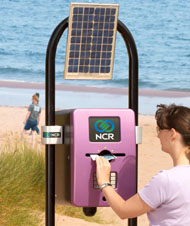News
NCR has sunny outlook on battery/solar power for ATM
August 17, 2003
LONDON -- Research carried out by NCR Corporation (NYSE: NCR) in cooperation with the University of Dundee, Scotland may be the key to ATM deployment in some of the more remote corners of the globe.
According to a news release, The Dundee research has shown how an ATM could run on DC current from batteries powered by a solar panel.
Machines based on solar power could be utilized in conjunction with mobile communication technology (such as GSM or GPRS) in areas with power supply problems or where there are no landline communications and dial-up infrastructure in place.
Solar panels would enable an ATM to operate for long periods without battery changes, according to the release. In areas with high levels of sunlight or where usage is light, continuous operation is possible.
 |
NCR's HARP concept ATM, which can run on battery and solar power. |
While the research indicated that regions with high levels of sunshine were optimal for solar-powered ATMs, results were also promising for less sunny locales.
Testing took place in Dundee in March to determine the levels of light required to operate a wireless ATM. Even in the cloudy conditions dominant in Scotland in March, the tests showed that generating solar power was possible, though a bigger panel would be needed to get the same performance as in sunnier regions.
"The system can work anywhere where there's daylight," said Mark Grossi, chief technology officer for NCR's Financial Solutions Division. "Using just two (24-volt) batteries, one will run the ATM while the other is being recharged using solar power."
The solar power trials are an extension of research carried out using NCR's Handy Amounts in Remote Places (HARP) battery-operated wireless concept ATM. Designed originally as an event ATM, HARP could be installed for use at a football match or on a boat.
(See related story NCR hopes new HARP concept plays well with ATM world)
Market pull and commercial viability will determine if and when HARP or ATMs incorporating some of the features of HARP are deployed.
"We are working with customers around the world to validate the business case that supports the concept," Grossi said. "It may be that some of the key technologies used in HARP, such as wireless technologies and battery/solar power will become integrated into our existing product range."
Because of HARP's small size (110 pounds and 2 feet tall), it would make sense to incorporate security features such as GPS (Global-positioning System) tracking and note staining technology, according to the release.
HARP was developed in NCR's Room 504 in Dundee. Other Room 504 prototypes have included the Freedom series of machines, one of which rather infamously resembled a red egg and lacked a card reader or screen. That design was equipped with an electronic sensor that responds either to infrared or Bluetooth signals.
(See related stories NCR's Freedom is just another word for "advanced" at NACS and Freedom from cards, buttons, screens)









